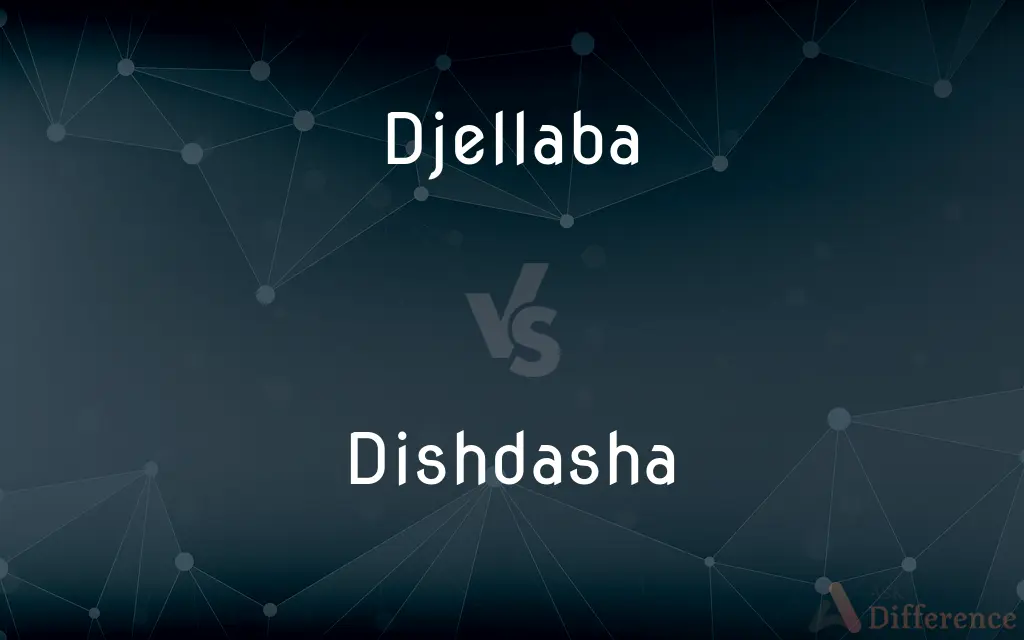Djellaba vs. Dishdasha — What's the Difference?
Edited by Tayyaba Rehman — By Fiza Rafique — Updated on May 6, 2024
Djellaba features a hood and loose fit, common in North Africa; dishdasha has a straight cut and no hood, primarily worn in the Arabian Peninsula.

Difference Between Djellaba and Dishdasha
Table of Contents
ADVERTISEMENT
Key Differences
A djellaba is traditionally worn in North African countries like Morocco and Algeria, characterized by its loose-fitting style and attached hood, which helps protect against sun and sand. On the other hand, the dishdasha, also known as a thobe, is the traditional attire in Arab countries like Saudi Arabia and Oman, distinguished by its long sleeves and a collar, but typically lacks a hood.
The djellaba often comes in darker, earthy colors or sometimes in striped patterns, suitable for blending into the desert landscapes of North Africa. Conversely, the dishdasha is usually found in lighter colors such as white or pastel shades, which effectively reflect the harsh sunlight found in the Arabian Peninsula.
In terms of material, djellabas are frequently made from wool or cotton, depending on the season, with thicker materials used for cooler weather. Whereas dishdashas are generally crafted from lighter fabrics like cotton or synthetic fibers, optimized for the hot climate of the Gulf region.
Regarding cultural significance, the djellaba can be worn for both everyday activities and special occasions, often accessorized with slippers and a fez hat. The dishdasha, while also versatile, is usually paired with a keffiyeh and iqal, especially in formal settings or during important religious observances.
The design of the djellaba includes a front button placket which can be opened or closed depending on the weather, adding a practical element to its design. In contrast, the dishdasha often features a tassel at the neck, which serves both a decorative and functional purpose, as it can be used to absorb sweat.
ADVERTISEMENT
Comparison Chart
Origin
North Africa (e.g., Morocco, Algeria)
Arabian Peninsula (e.g., Saudi Arabia, Oman)
Hood
Yes
No
Typical Colors
Darker, earthy tones
Light colors like white or pastels
Material
Wool or cotton
Cotton or synthetic fibers
Cultural Pairings
Often worn with slippers and a fez
Commonly paired with a keffiyeh and iqal
Compare with Definitions
Djellaba
A long, loose-fitting robe with a hood, worn in North Africa.
He wore a blue djellaba to stay comfortable during the cool desert evening.
Dishdasha
A long robe worn by men in the Arabian Peninsula, usually without a hood.
He chose a crisp, white dishdasha for the summer ceremony.
Djellaba
Equipped with a front button placket.
He buttoned up his djellaba as the evening wind started to pick up.
Dishdasha
Predominantly found in light colors to reflect sunlight.
During the festival, the streets were filled with men in bright dishdashas.
Djellaba
Traditional Moroccan attire, suitable for both casual and formal occasions.
For the wedding, all the men wore colorful djellabas.
Dishdasha
Made from lightweight materials for hot climates.
His dishdasha was made of a breathable fabric perfect for the humid weather.
Djellaba
May feature decorative patterns, especially in Berber cultures.
His djellaba had intricate patterns that told stories of his heritage.
Dishdasha
Features a tassel at the neckline.
He adjusted the tassel on his dishdasha before entering the mosque.
Djellaba
Often made from wool in colder months.
Her winter djellaba was thick enough to shield her from the mountain winds.
Dishdasha
Worn for daily activities and special religious occasions.
He wore his best dishdasha to the Friday prayer.
Djellaba
A long, loose, hooded garment with full sleeves, worn especially in Muslim countries.
Dishdasha
A long robe with long sleeves, worn by men from the Arabian peninsula.
Djellaba
A loose-fitting, ankle-length hooded robe worn by men in North Africa.
Dishdasha
A loose, long-sleeved garment; a thobe.
Dishdasha
An ankle-length robe with long sleeves worn by some Arab men.
Common Curiosities
What fabrics are typically used to make a djellaba?
Djellabas are typically made from wool or cotton, with fabric choices often depending on the season.
How do cultural contexts influence the wearing of djellabas versus dishdashas?
Cultural norms dictate that djellabas are worn in North African daily life and rituals, while dishdashas are integral to Arabian social and religious practices.
Do dishdashas come in any other colors besides white?
Yes, dishdashas can also be found in pastel shades and occasionally in darker colors for specific occasions.
What are the typical occasions for wearing a djellaba?
Djellabas are versatile, worn in daily life, at festivals, and during religious ceremonies.
Can dishdashas be customized for personal style?
Yes, individuals often customize their dishdashas with various fabrics, colors, and even intricate embroidery.
What differentiates a formal djellaba from a casual one?
Formal djellabas may feature finer materials and detailed embroidery, while casual ones are simpler and often plainer.
What adjustments are made to dishdashas to suit the hot climate of the Arabian Peninsula?
Dishdashas are made from breathable materials and are designed to be loose to allow for air circulation.
Are there modern interpretations of the djellaba in contemporary fashion?
Yes, modern designers often reinterpret djellabas with new fabrics and cuts to suit contemporary fashion trends.
Do younger generations in Arabian countries still wear dishdashas?
Yes, it remains a symbol of cultural pride and identity, widely worn by all ages.
Is there a specific way to maintain a dishdasha?
Dishdashas require regular washing and ironing to maintain their crisp appearance, especially in lighter colors.
What role does the djellaba play in North African weddings?
It's commonly worn by guests and sometimes the groom, signifying respect and celebration.
How has global fashion influenced the traditional designs of djellabas and dishdashas?
Global fashion has introduced new materials and elements of design, such as prints and cuts, making these garments more versatile and appealing internationally.
How does the functionality of a djellaba's hood serve its wearer?
The hood on a djellaba not only protects from the elements but also provides privacy and warmth when needed.
Can a dishdasha be worn with Western-style shoes?
While traditionally worn with sandals, it's increasingly common to see them paired with Western-style dress shoes in formal settings.
How does the length of a dishdasha affect its wearability?
Dishdashas are usually ankle-length to provide modesty and protection from the sun while maintaining ease of movement.
Share Your Discovery

Previous Comparison
Hayfork vs. Pitchfork
Next Comparison
Flogging vs. ScourgingAuthor Spotlight
Written by
Fiza RafiqueFiza Rafique is a skilled content writer at AskDifference.com, where she meticulously refines and enhances written pieces. Drawing from her vast editorial expertise, Fiza ensures clarity, accuracy, and precision in every article. Passionate about language, she continually seeks to elevate the quality of content for readers worldwide.
Edited by
Tayyaba RehmanTayyaba Rehman is a distinguished writer, currently serving as a primary contributor to askdifference.com. As a researcher in semantics and etymology, Tayyaba's passion for the complexity of languages and their distinctions has found a perfect home on the platform. Tayyaba delves into the intricacies of language, distinguishing between commonly confused words and phrases, thereby providing clarity for readers worldwide.
















































